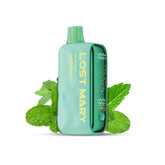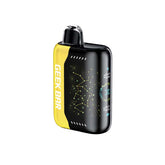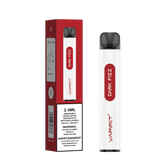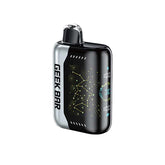Can You Bring a Vape on a Plane?
Traveling with a vape can be a little worried. Different countries and airlines have their own rules about vapes and e-liquids. Therefore, it's essential to know what you can and can't bring on board. In this blog, we’ll guide you through the key dos and don’ts of traveling with a vape.
Can You Bring a Vape on a Plane?
Sure, you can. But there are specific rules you need to follow. Airlines and airports generally allow vapes in your carry-on/hand luggage but not your checked baggage. The main concern for authorities is the potential fire risk posed by the lithium-ion batteries in e-cigarettes.
Plus, the extra refill or e-liquid could be placed in the hold if you need. And the ideal way to bring your vape on a plane is by using a dedicated carry case.
How Many Vapes Can You Bring on a Plane?
Actually, different airline has different rules. Be sure to verify the policy with your airline before flight. Generally, most airlines permit 15 to 20 disposable vapes per person, so if you’re only carrying a few, you’re unlikely to run into any issues.

How to Bring Your Vape on a Plane?
Carry-On vs. Checked Luggage
Carry-On: Allowed vape device with a built-in battery, as well as any spare batteries. Make sure the device is switched off during the flight. All vaping devices, batteries, and accessories must be properly secured to avoid damage or unintentional activation while in transit.
Checked Luggage: You may could pack a vape in your checked bag if the battery has been removed. Any device with battery is banned.
Battery Safety Guidelines
1. Carry-On Only: Always pack vape batteries in your carry-on luggage.
2. Use Protective Cases: Store spare batteries in cushioned, non-metallic cases that keep the terminals separated to prevent short-circuiting.
3. Turn Off Devices: Ensure all vaping devices are powered off.

4. Avoid Damaged Batteries: Do not bring batteries that are damaged, swollen, or leaking, as they pose a significant safety risk.
5. Limit Quantities: Only bring the number of batteries you need for personal use.
6. Follow Airline Rules: Check with your airline for specific regulations.
Note: Each lithium-ion or lithium metal battery must not exceed a capacity of 100 Wh or a lithium content of 2 g.
What Happens if You Put a Vape in Your Carry-On Bag?
It is the right way to take your vape on board. However, it's essential to ensure the device is powered off during the flight. At the security checkpoint, your carry-on bag will be scanned by an X-ray machine. TSA may ask you to remove it from your bag for additional screening, so be prepared for that. After the scan is complete, you’ll be free to continue on your journey.

What Happens if You Put a Vape in Your Checked Luggage?
To begin with, it is against the rules and could lead to the confiscation of your device. Then, if airport security finds it in your checked bag, they may remove it, and you could face penalties.
How to Bring Your Vape Juice on a Plane?
TSA Liquid Rules
1. 1 Ounce (30 mL) Limit or Smaller: Each bottle of vape juice must not exceed 1 ounce (30 mL).
2. Clear, Resealable Bag: All liquids, including e-juice, must be placed in a single, quart-sized, clear, resealable zip-top plastic bag.
3. One Bag Per Passenger: You’re allowed only one liquids bag, so make sure your vape juice fits along with your other liquid items like toiletries.
4. Checked Luggage Option: If you have e-juice in larger quantities, you can pack it in your checked luggage. However, ensure the bottles are sealed tightly to prevent leaks or you could choose to pack extra e-liquid in plastic bag.
5. Declare if Necessary: If security requests to see the contents of your liquids bag, comply and declare your vape juice.

Packaging and Storage Tips
1. Check Size Limits: Each bottle of vape juice must be 1 ounce (30 mL) or smaller to comply with TSA liquid regulations.
2. Use a Leak-Proof Container: Ensure your vape juice bottle is tightly sealed to prevent leaks due to cabin pressure changes. You'd better place it in a small, leak-proof plastic bag for added protection.
3. Place in a Clear Bag: Follow the TSA's 3-1-1 rule for liquids: store all your liquids, including vape juice, in a single, quart-sized clear plastic bag.
4. Pack Upright: Store your vape juice upright in your carry-on bag to minimize the risk of leaks or spills.
5. Avoid Temperature Extremes: Keep your vape juice away from direct sunlight or extreme temperatures. High heat can alter the consistency and flavor of the juice, while cold temperatures may thicken it.
6. Separate from Other Liquids: When possible, keep your vape juice separate from other liquids in your bag to reduce the chance of cross-contamination and make inspection easier.
Can You Vape on a Plane?
Absolutely No, vaping is not allowed on planes, and it is illegal. This includes both traditional cigarettes and e-cigarettes. The use of electronic cigarettes is prohibited during the flight, and you could face hefty fines or penalties if you are caught vaping onboard. Be sure to follow the airline’s no-smoking and no-vaping policies. And if you are craving for nicotine very much, then prepare alternatives in advance like nicotine gum or pouches.

Can You Vape at the Airport?
Vaping policies at airports vary by location. Some airports have designated vaping areas, while others may ban it altogether. Always check the airport’s specific rules before vaping in public areas or ask an employee for help. You’ll typically find vaping lounges in international airports, but in domestic airports, the availability of such spaces is less common.
If you have a layover at an airport without smoking area, you’ll have to leave the airport to vape. For international airports, this means going through customs and re-entering the airport after vaping, which requires passing through security again.
Can You Buy Vape Juice and Replacement Coils Abroad?
It's hard to say. Some countries prohibit the sale of nicotine-containing vaping products, while others ban vaping products altogether. Make sure to research the regulations in your destination country before traveling internationally.
Vaping laws around the world can be quite complex. In some countries, purchasing vaping products is as easy for adults as buying tobacco products. In others, it may be legal to own vaping products, but buying, selling, or importing them is prohibited. Some countries have even imposed a complete ban on vaping. Additionally, certain regions have restrictions on e-liquid flavors, while others only allow the sale of nicotine-free vaping products.

Always Learn the Local Vaping Laws Before You Travel
When traveling, avoid vaping in public unless you're sure it's allowed. Consider whether you'll be able to vape in the same places you do at home, as many countries and regions have public smoking bans that also apply to vaping. As a general rule, if smoking is prohibited in a certain area, vaping is likely not permitted either.
Before traveling, make sure to familiarize yourself with local vaping laws to avoid any unwanted surprises.
What Do Some Top Airlines Say?
In addition to the TSA, many other airlines have their own rules regarding bringing vapes on board. And here are some related information from them.
• British Airways: Vapes are allowed in carry-on luggage, but they prohibit any vaping on board.
• Easy Jet: All vapes and batteries are only allowed in carry-on luggage. And the number of spare batteries are limited in 2.
• Emirates: All of the Emirates flights are not allowed smoking, including vapes.
• American Airlines: Vapes are permitted only in carry-on luggage. And “NO SOMKING”, which includes vapes.
• Air Canada: Vapes are allowed in carry-on or checked baggage. E-cigarettes (or vapes) and accessories are allowed, along with e-liquid refills of 100 mL (3.4 ounces) or less. These items can be screened without needing to remove them from their cases or bags.
• British Airways: Vapes are permitted in carry-on luggage, and vaping is prohibited in the cabin.
Is Vaping Legal Where I’m Going?
Check the legal status of vaping in your destination country. While vaping is legal in many places, some countries have imposed restrictions or outright bans. Do your homework and ensure you're compliant with local regulations to avoid fines or confiscation of your device. Here are some countries about vaping laws for your reference:

Legal with Clear Regulations
United States: Federally legal, but with age and product restrictions.
United Kingdom: Legal, actively promoted as a smoking alternative.
Canada: Legal with regulations on age, nicotine levels, and public use.
New Zealand: Legal and encouraged for smoking cessation.
Australia: Legal for non-nicotine products; nicotine e-liquids require a prescription.
France: Legal, but public use is restricted in certain areas.
Germany: Legal, regulated under tobacco laws.
Italy: Legal with restrictions on advertising and public use.
United Arab Emirates (UAE): Legal, but sales are regulated and public use is restricted.
Japan: Legal for nicotine-free products; nicotine-containing e-liquids require a prescription.
South Africa: Legal but regulated, with restrictions on advertising.
South Korea: Legal with high taxes on e-cigarettes.
Malaysia: Legal in some states, but products with nicotine require a license.
Countries Where Vaping Is Illegal
In these countries, vaping is outright banned, including the sale, import, possession, or use of vape products:
Singapore: Complete ban on import, sale, and use; violations result in fines or imprisonment.
Thailand: Vaping is banned; severe penalties for possession, including jail time.
India: Nationwide ban on production, sale, import, and advertisement of vaping products.
Brazil: Sale, import, and advertising of vaping products are prohibited.
Mexico: Ban on importing and selling vape products, although enforcement varies.
Argentina: Banned the sale and distribution of e-cigarettes.
Hong Kong: Complete ban on the sale, import, and possession of vaping products as of 2022.
Cambodia: Total ban on the sale, import, and use of vaping products.
Domestic and International Vaping Laws
In some countries, vaping is treated the same as smoking, meaning it’s subject to similar laws about public use and transport. Internationally, vaping laws can differ significantly—what’s allowed in one country may be banned in another. Always check ahead to ensure you’re in compliance with local regulations.
Can You Take Vapes on a Plane Internationally?
Yes, you can generally take vapes on international flights, but be aware of the regulations for both the airline and the destination country. Ensure your vape and e-liquid are properly packed according to the guidelines, and confirm whether vaping is allowed at your destination.

Can I Vape on a Cruise?
Vaping policies on cruise ships vary depending on the cruise line. Some allow vaping in designated deck areas or specific zones, while others prohibit it entirely. Be sure to check your cruise line's specific vaping policy before embarking on your journey.
Conclusion
Traveling with a vape requires careful planning. Always pack your vape and e-liquids in your carry-on, follow battery safety rules, and check local regulations at your destination. Adhering to airline policies and staying informed ensures a hassle-free journey while keeping you compliant with safety standards. Safe travels!


























